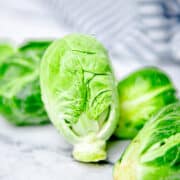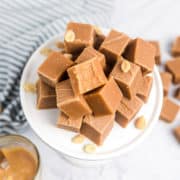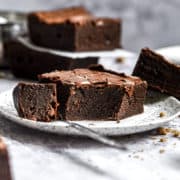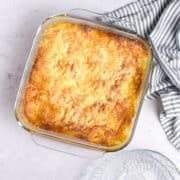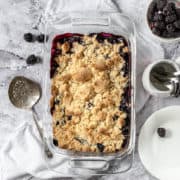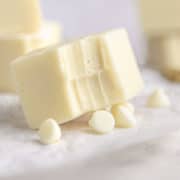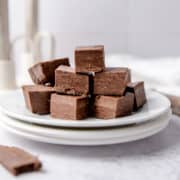Brussel sprouts are a versatile, cruciferous vegetable that can be served raw or cooked, soft or crispy. They look like mini cabbages and are actually in the cabbage family, along with broccoli and kale. You can buy large or small sprouts either on or off the stalk. It's important to know how to store Brussel sprouts so you can keep them fresh.

Jump to:
A lot of people have a love/hate relationship with these little round, green vegetables. If you've had badly cooked, mushy sprouts, that might have put you off trying them again!
However, there are some really good ways to prepare them and you should definitely give them another chance to please your palate.
I love to slice loose sprouts thinly and sauté with bacon. They're also nice thinly sliced, raw, and added to a salad. You can steam, roast, or fry them too. When cooked rice, Brussel sprouts offer a crisp texture and sweet, earthy flavor.
What Are Brussel Sprouts?
Brussel sprouts (Brassica Oleracea) are a cool-season crop that are typically harvested during fall and early winter. They are green and roundish and 1 or 2 inches in diameter. These vegetables are harvested by picking them off one by one from the stalk or cutting the whole stalk off.
Although most sprouts are bright green, you can also get a purple-green variety which was created by crossing Brussel sprouts with red cabbage.
This nutritious vegetable gives you fiber, folate, and antioxidants along with Vitamins C and K. Available from most grocery store vegetable aisles, Brussel sprouts can be served in a variety of ways, with examples including as a side dish or raw as part of a salad.
They have a somewhat undeserved reputation. If you've only had soggy, overcooked Brussel sprouts, you might not want to try them again. However, cook them properly and you might love them!
Sauteed Brussel spouts with bacon bear very little resemblance to mushy, over-boiled ones. So if you haven't enjoyed Brussel sprouts for a while, it's time to reacquaint yourself with this healthy vegetable.
Although sprouts are believed to have originated in Italy, they became very popular as a vegetable crop in the 1500s in Belgium, hence their name.
They were introduced into Louisiana around 1800, and they started to be commercially produced in 1925. Production largely moved to California's central coast in the 1940s and California is still a major cultivator of Brussel sprouts today.
The growing season is between June and December, although Brussel sprouts are a cool weather crop and you can often find them at farmers' markets during the fall. Although they don't mind a light frost, warm temperatures make them open and turn yellow, so they won't grow anywhere hot. Hard freezes can also kill them. The best time to enjoy sprouts is during the fall.
How to Choose Brussel Sprouts
When you buy fresh Brussel sprouts, you should choose ones with compact heads and avoid any that look wilted or dull. This applies to them whether you buy them on or off the stalk. I look at them very closely because little pinholes can be a sign that there are bugs in the sprouts.
The best quality Brussel sprouts will be bright green, firm, and free from yellow or brown blemishes, black spots, or little holes caused by bugs.
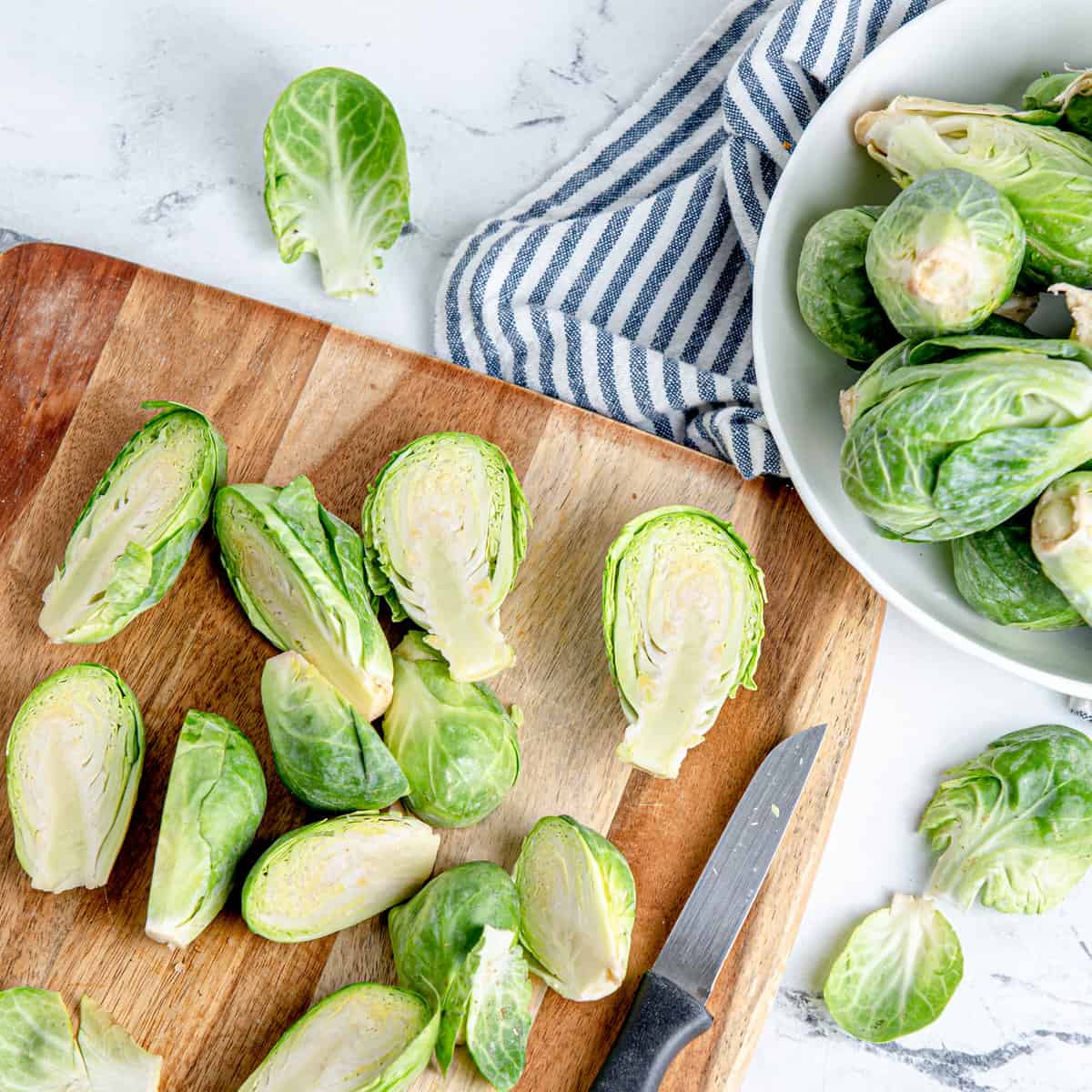
How to Store Brussel Sprouts
Have you purchased some Brussel sprouts from the grocery store or farmers' market? Knowing the best way to store these vegetables means you can extend their shelf life for as long as possible.
- Don't trim or wash loose Brussel sprouts or ones on the stalk before storing them.
- If they're loose, examine them and discard any that look bad.
- Keep the unwashed Brussel sprouts in a plastic bag or airtight container, so they don't get too much air, in the fridge crisper drawer.
- They should be fine for a week, but they will lose their sweetness the longer you keep them.
- Brussel sprouts kept in a dry place at room temperature will only stay fresh for a couple of days.
- Brussel sprouts on the stalk stay fresh for longer, so for the best results keep them on the stalk until you're ready to use them.
- Cut Brussel sprouts should be kept in an airtight container and used within 2 days, which isn't a long time, so it's best not to chop more than you need.
Another option is to freeze Brussel sprouts. Remove the outer leaves then remove them from the stalk if they're still on it. Soak the sprouts in warm water for about 10 minutes to clean them. Rinse, pat with paper towels to remove excess water, put them in freezer bags, and freeze for up to a year.
You can also blanch loose large sprouts in boiling water for 5 minutes (3-4 minutes for smaller sprouts) then plunge them into ice-cold water for 3 minutes.
I always make sure they're completely dry after their ice bath, and then freeze them on a parchment paper lined cookie sheet or baking sheet in a single layer before transferring them into freezer bags.
How to Identify Rotten Brussel Sprouts
There are a few different ways to tell if your spouts are beyond their prime. When this vegetable goes bad, you will see loose leaves instead of compact ones, and they might look wilted.
Black spots are another indicator of spoilage. These are caused by a fungus and are the precursor to the vegetable turning yellow or brown. When I see little brown spots on the bottom leaves, I know this is the first sign of fungal growth and from there they spread all over the plant.
Bad Brussel sprouts usually have a rotten smell and might also have a slimy texture. Fresh sprouts have a slight sulfuric smell because of their hydrogen sulfide content but bad ones will smell vinegar-like or sour. If in doubt, throw them out because rotten sprouts can make you sick.
Common Questions
This vegetable has a polarizing reputation. Unfortunately, a lot of people think they hate them because they've had a bad experience in the past, such as overcooked, mushy, boiled sprouts. This isn't the right cooking process to choose.
Actually, you don't even have to cook sprouts. Slice them thinly and toss with salad leaves, sliced radish, and carrot, along with some extra-virgin olive oil and red wine vinegar for a crunchy salad. If you do want to cook them, try sauteing them with chopped bacon and a pinch of cayenne pepper too if you want some heat.
This is one of my favorite recipes for a side dish, and I also love the contrast between this and sweet potatoes, so often make those too when I'm making sprouts.
If you have leftover Brussel sprouts, you should throw them out if they've been at room temperature for more than 2 hours. If not, you can refrigerate them in an airtight container and use them within 3 days. One of my favorite ways to prepare fresh sprouts is to fry them with bacon, a pinch of sugar, and some cayenne pepper, but leftovers (if there are any) don't tend to last more than a day because they're so tasty!
Most of us remember eating (and disliking) sprouts during childhood, but how come they seem to taste better these days? Hans van Doorn, a Dutch scientist, determined the chemical that gives sprouts a bitter taste back in the 1990s. This chemical, glucosinolate, was eliminated by breeders, and since then Brussel sprouts have had a more palatable flavor.
Something else that's interesting to note is not everyone has the same palate and some people taste glucosinolate more strongly than others. The new Brussel sprouts cultivars have had that chemical bred out of them so, even if you hated them as a kid, give sprouts another chance. You might find you love them!
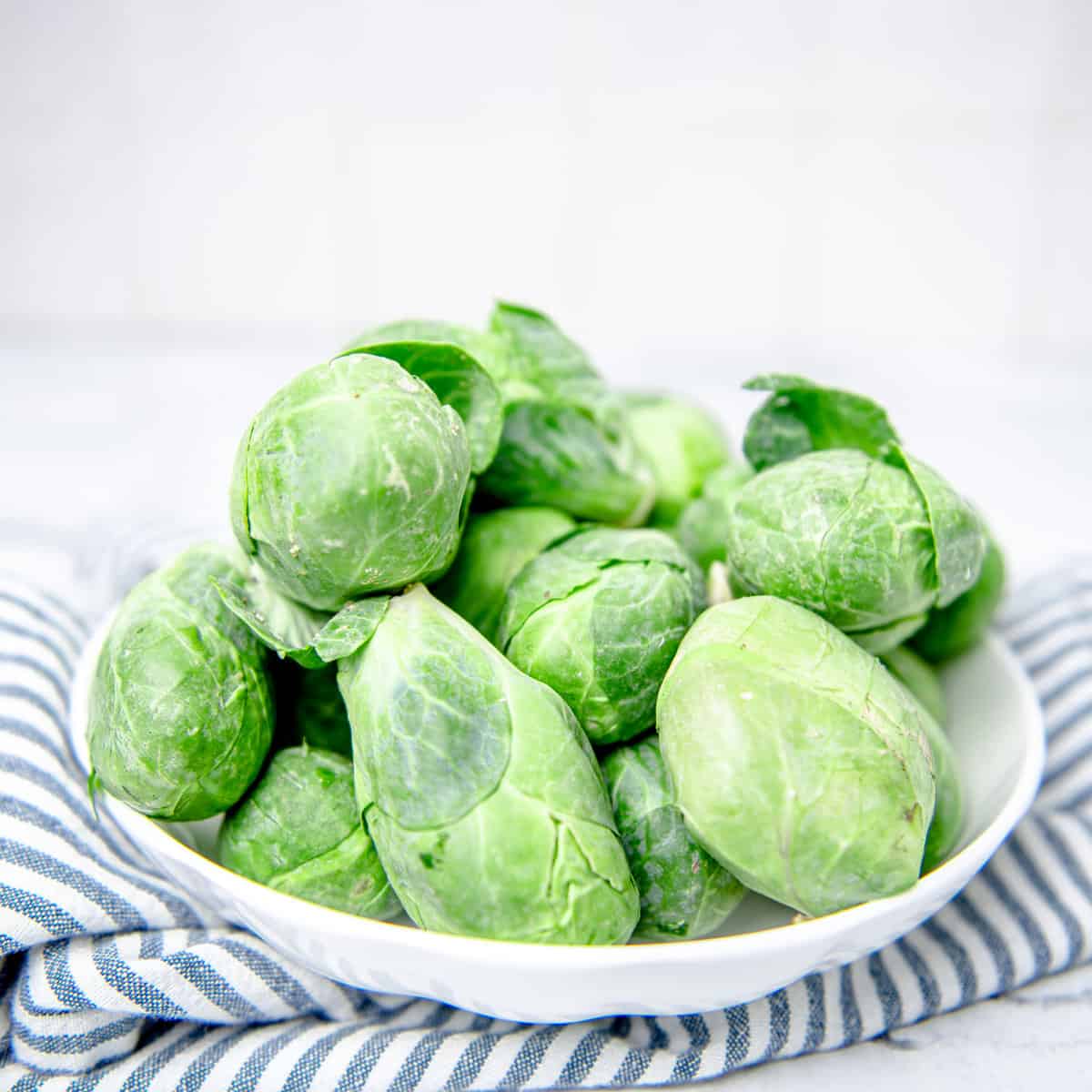
Curious Facts
- 70 million pounds of Brussel sprouts are grown in the United States every year, with California being the top-producing State.
- Linus Urbanec from Sweden ate a record 31 Brussel sprouts in one minute in 2008, using a toothpick and only eating one at a time.
- Eating a cup of Brussel sprouts provides 195% of your daily Vitamin K recommendation as well as 125% of your daily Vitamin C recommendation.
Once you know how to store Brussel sprouts, you might want to experiment with different dishes. The nutty flavor of sprouts goes with anything from bacon to salads. Slice them with a sharp knife and toss with cabbage and salad leaves, or cut them in half and pan-fry with chopped bacon until crisp-tender.
